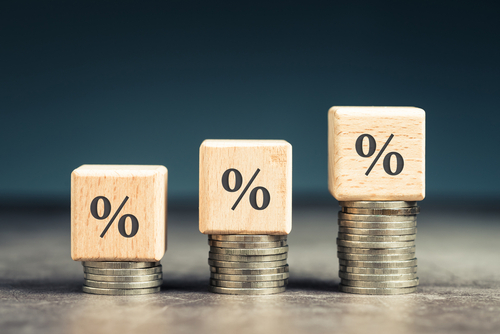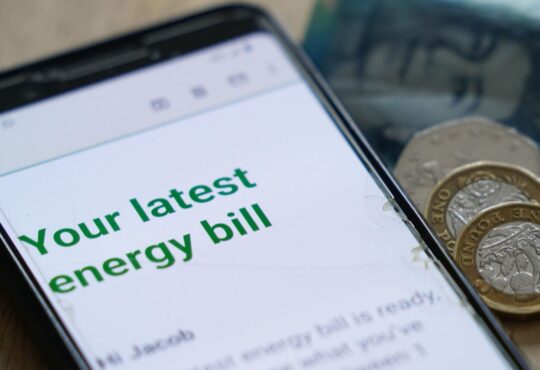
Here are the average annual percentage rates (APR) on 30- and 15-year fixed mortgage refinances and 5/1 ARM refinances:
Today’s Mortgage Refinance Rates
The average APR for a 30-year fixed refinance loan increased to 6.73% from 6.63% yesterday. This time last week, the 30-year fixed APR was 6.67%. Meanwhile, the average APR on a 15-year fixed refinance mortgage is 6.12%. This same time last week, the 15-year fixed-rate mortgage APR was 5.93%.
The average APR on the 30-year fixed-rate jumbo mortgage refinance is 6.73%. Last week, the average APR on a 30-year jumbo was 6.68%. The average APR on a 5/1 ARM refinance is 7.35%. Last week, the average APR on a 5/1 ARM was 7.41%.
Read In-depth Refinance Rates Analysis by Day
What Experts Say About Current Refinance Rates
Most housing and mortgage experts predict that refinance rates will land somewhere between 5% and 6% by the end of the year. As interest rates on a mortgage refinance have climbed during 2022, it will be less appealing for mortgage borrowers to refinance their loan if their new rate is close to the one they’re already paying—especially after adding up the closing costs in order to refinance.
Here are some mortgage refinance rate forecasts for the rest of the year:
“With mortgage rates soaring to the highest levels since 2008, the opportunity to refinance into a lower rate has largely passed for most homeowners,” says Danielle Hale, chief economist for Realtor.com. Hale expects rates to settle between 5.5% and 6% from now to the end of 2022.
Mike Fratantoni, chief economist for the Mortgage Bankers Association (MBA) says rates might have already peaked this year, which could provide an opportunity for a few homeowners to refinance.
Rates “could stay between 5% and 5.5% through the remainder of 2022,” he says.
Who Has the Best Refinance Rates?
To find the best refinance rates, you could start with our list of best mortgage refinance lenders. Just keep in mind that some of the rates you see online might not apply in every situation—say for a credit score that’s much lower or much higher than average. You can also try to negotiate an optimal rate with your current lender by shopping around and presenting some good offers from other lenders on both loan rates and terms.
Best Mortgage Refinance Lenders
Homeowners still have time to lower their monthly mortgage payments by refinancing, as mortgage rates are still relatively low. Homeowners who wish to save money by locking in a lower rate, reduce the length of their mortgage and access some of their home equity without selling their house, now is an ideal time to crunch the numbers to see if refinancing makes sense.
Before you refinance your home, you should shop around for a lender that will offer you the best rate and repayment terms that suit you. Forbes Advisor has reviewed the best refinance lenders. These companies offer some of the most competitive rates and low fees, which are key criteria for refinancing.
3 Steps to Get the Lowest Refinance Rate
The main goal of most mortgage refinances is to lower your interest rate and maximize your savings. Naturally, the lower the rate the bigger the savings.
But just because lenders offer a certain rate doesn’t mean you’ll necessarily qualify for it. Often lenders will publish their lowest rate available, but those rates are reserved for borrowers who tick several boxes, like holding a high credit score and a low loan-to-value ratio.
Borrowers can put themselves in the best position to get the lowest rate by doing these three basic things:
1. Raise Your Credit Score
If your credit score is below 760, then you might not qualify for the very best rate lenders offer. That doesn’t mean you can’t get a lower rate than what you currently have, but there is room to improve your score and boost your savings. Before you apply for a mortgage refinance, check your credit score and get a copy of your credit report.
If you find any errors on your credit report, be sure to report them to both the credit bureau and the business that made the error as soon as possible. Both parties must correct the information in order for it to change on your credit report and be reflected in your credit score.
You can bump up your credit score by paying off credit card debt and reducing how much you use your cards. If you do use credit cards for rewards and points, try to pay them off immediately—don’t wait for your monthly statement to come in because your score can change daily.
Avoid applying for new lines of credit before you apply for a mortgage refinance, as credit applications can bring down your score. However, submitting multiple mortgage applications in an effort to get the lowest rate possible won’t hurt your score.
Credit bureaus count multiple mortgage applications within the same period of time as just one application because they recognize that activity as comparison shopping, rather than trying to open multiple lines of credit.
2. Shop Around for the Best Rate
The second step in ensuring you get the best rate available to you is to shop around. Make sure you compare the APR between lenders, not just the rate. The APR is the all-in total of your mortgage costs, which can vary by lender, and will include your closing costs if rolled into your loan.
You should compare offers from at least three lenders before making a decision. But when comparing the interest rate and APR, consider these two scenarios:
If you plan to stay in the home for an extended period, getting the lowest mortgage rate can be more important than paying the lowest closing costs.
If you don’t plan to stay for more than a couple of years, you should look closely at the lender’s loan estimates, which will show you the projected five-year cost. Choose the offer with the lowest initial price tag.
3. Keep Your Loan-to-value Ratio Low
Finally, the lower your loan-to-value ratio is, the lower your interest rate will be. If you don’t have to take cash out of your home when you refinance, you might want to avoid doing so as that will bump up your LTV and likely result in a higher interest rate.
The loan-to-value ratio measures the amount of financing used to buy a home relative to the value of the home. Maximum LTVs permitted when refinancing vary based on the type of property you’re refinancing, whether the loan is a fixed-rate or an adjustable-rate mortgage (ARM) and whether you’re doing a standard refinance or a cash-out refi.
Pros and Cons of Refinancing
You should consider refinancing your mortgage if refinancing can lower your monthly mortgage payment by reducing your interest rate or increasing your loan term. Refinancing also can lower your long-run interest costs through a lower mortgage rate, shorter loan term or both. It also can help you get rid of mortgage insurance.
The cons of refinancing your mortgage are that you’ll have to pay hefty closing costs, which include the origination fee, appraisal fee, title insurance fee and credit report fee, among other line items. These costs typically amount to 2% to 6% of the new mortgage total.
You’ll need to know the loan’s closing costs to calculate the break-even point where your savings from a lower interest rate exceed your closing costs. You can calculate this point by dividing your closing costs by the monthly savings from your new payment.
You may also have to stay in the home longer in order for the refinance to actually save you money. If you sell your home before you have enough equity built up to cover both the closing costs of the refinance and the new sale, you could end up losing money.
Types of Mortgage Refinancing
The three most common types of mortgage refinance options are: rate-and-term refinance, cash-out refinance and cash-in refinance.
The rate-and-term refinance allows homeowners to lower their interest rate and/or change the term, which is the length of time borrowers must pay on their loan. For example, you might want to refinance your 30-year mortgage with a 3.5% interest rate into a 15-year mortgage with a 3% rate. This will help you lower the amount you pay in interest and pay off the mortgage faster.
A cash-out refinance gives homeowners the opportunity to access the equity in their home, with the option to also lower their interest rate.
A cash-in refinance is when homeowners apply cash to the principal, which can help them lower their loan balance, eliminate private mortgage insurance, get a better interest rate or qualify for a refinance.
Mortgage Refinance Calculator: Should I Refinance My Home?
Frequently Asked Questions (FAQs)
What Is a Mortgage Refinance?
Mortgage refinancing is when you replace one home loan with another in order to access a lower interest rate, adjust the loan term or consolidate debt. Refinancing requires homeowners to complete a new loan application and may involve an appraisal and inspection of the home. Lenders also rely heavily on an applicant’s credit score and debt-to-income ratio when deciding whether to extend a new loan.
In addition to the qualification process, refinancing costs can be substantial, totaling up to 6% of the original loan’s outstanding principal. So it’s important to consider whether a refi is the right move for you.
How Do I Qualify for Refinancing?
Qualifying for a refinance is the same as qualifying for a purchase home loan, as lenders want to make sure you can afford the payments and that you will make them on time per your contract. Although each lender has different requirements, generally all lenders will look at your credit score, debt-to-income ratio (DTI), income and home equity.
For conventional mortgages, a credit score between 620 and 720 is preferred. The credit score minimum might also depend on your cash reserves, DTI and the loan-to-value ratio. Also, lenders usually reward high credit scores with the lowest available interest rates.
FHA loans have lower minimums than conventional mortgage refinances, but some lenders might apply a credit overlay, which means they will raise the minimum score to offset risk:
- 500 if your new loan has an LTV of 90% or less
- 580 if your new loan has an LTV of over 90%
There is no credit check for an FHA streamline refinance. There are also no credit score minimums for USDA or VA refinances; however, lenders might apply their own standards to these refinances.
How Do Refinance Rates Work?
Mortgage refinance rates vary by lenders based on a whole host of different factors. Some lenders might charge lower rates because they need more business and are able to take on more risk, for example. Likewise, lenders have different qualifications for getting low rates.
If you’re considering refinancing to lower your mortgage rate, then you’ll want to compare interest rates and fees by lender. Many lenders don’t disclose fees or even rates online so you might have to contact them and ask for a list of their fees and what their rates are.
In order to get an even more accurate description of how much the loan will cost you, you can apply for multiple loans and receive loan estimates based on your credit score, loan-to-value (LTV), debt-to-income ratio and other financial details.
How Can I Find the Best Refinance Rates?
It’s always a good idea to get multiple loan estimates when you’re trying to capture the lowest rate available. You can use the best estimate to negotiate with other lenders, which might result in getting a lower rate or reducing certain administrative fees.
When you’re shopping around, be sure to ask about any discounts—including appraisal waivers—that might be available to you. Some financial institutions offer discounts to existing customers; you might also find military discounts.
When Is Refinancing Worth It?
There are many scenarios where refinancing makes sense. In general, refinancing is worth it if you can save money or if you need to access equity for emergencies.
Borrowers with FHA loans must refinance into a conventional loan in order to get rid of their mortgage insurance premium, which can save hundreds or thousands of dollars per year.
Some borrowers refinance because they have an adjustable-rate mortgage and they want to lock in a fixed rate. But there are also situations when it makes sense to go from a fixed-rate to an adjustable-rate mortgage or from one ARM to another: Namely, if you plan to sell in a few years and you’re comfortable with the risk of taking on a higher rate should you end up staying in your current home longer than planned.
What do you need to refinance your home?
Before you take any steps toward applying for a refinance, make sure you know exactly what you want, including the type of mortgage, term, and so on. Then get loan estimates from a few lenders, not just one. Once you know which lender you want to work with, gather your paperwork. Lender requirements may vary, but here’s a general checklist of documents you’ll likely need:
- W-2s or 1099s
- Recent pay stubs
- Most recent tax returns
- Statement of assets
- Statement of debts
- Proof of property insurance
- Appraisal
Check your rates today with Better Mortgage.
Faster, easier mortgage refinancing
Forbes Advisor adheres to strict editorial integrity standards. To the best of our knowledge, all content is accurate as of the date posted, though offers contained herein may no longer be available. The opinions expressed are the author’s alone and have not been provided, approved, or otherwise endorsed by our partners.
Was this article helpful?







